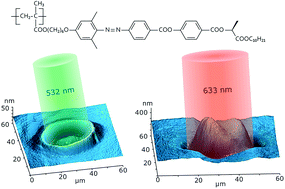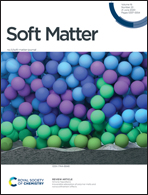Laser-induced formation of “craters” and “hills” in azobenzene-containing polymethacrylate films†
Abstract
Functional organic polymer materials with an ability to change their surface topography in response to external contactless stimuli, like light irradiation, have attracted considerable attention. This work is devoted to the study of contactless control of the surface topography and the formation of the surface features in the amorphousized and liquid crystalline films of two azobenzene-containing polymers. The investigated polymers are side-chain polymethacrylates containing azobenzene chromophores with two lateral methyl substituents in ortho-positions and differing in the length of flexible spacer with six and ten methylene units. Two lateral methyl substituents at the azobenzene chromophore ensure high photoresponses of these polymeric samples in the whole visible spectral range. Irradiation of the polymethacrylate films by focused polarized light of green (532 nm) and red (633 nm) lasers induces a specific photodeformation of the film surface. In the case of the green light formation of circular “craters” with anisotropic borders was found, whereas for the red light highly asymmetric “hills” were observed. The possible mechanisms of the surface topography formation and their features are discussed.



 Please wait while we load your content...
Please wait while we load your content...